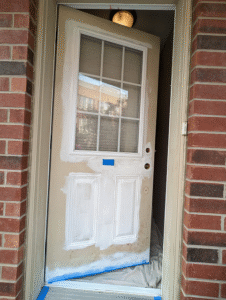How to Start a Front-Door Painting Business
 Turning homes’ first impressions into stunning statements can be a very lucrative cash earning niche.
Turning homes’ first impressions into stunning statements can be a very lucrative cash earning niche.
Here’s a step-by-step roadmap tailored to front-door painting specialists.
1. Validate Your Niche & Research Your Market
- Survey your area: Are homeowners repainting doors to boost curb appeal? Note local weather (sun, rain, freeze) that degrades finishes.
- Scope competition: What do other painting pros charge for door jobs? How do they market?
- Estimate demand: With home renovation spending on the rise, exterior painting remains steady work.
2. Master Specialized Door-Painting Skills
- Surface prep: Learn proper stripping, sanding, filling cracks and holes so paint adheres and lasts.
- Material know-how: Choose high-quality exterior enamels or acrylic-latex blends and exterior primers that withstand UV and moisture.
- Application techniques: Practice cutting-in by brush, using rollers for smooth finishes, and especially spray-painting with an HVLP gun for flawless door panels and recessed areas.
- Finishing: Apply multiple thin coats and topcoats; understand dry times and weather windows. Solid basic painting skills are essential to avoid costly callbacks.
3. Write a Business Plan & Legal Setup
- Business plan: Define your service menu (e.g., door removal, hardware painting, full refinish), pricing strategy, startup budget and revenue goals.
- Choose an entity (sole proprietorship, LLC) and register with your state.
- Licensing & insurance: Obtain a general contractor or specialty painting license if required. Secure liability and property-damage coverage—vital when working on homeowners’ entryways.
4. Invest in Tools & Materials
- Essential tools: • Portable door stands or sawhorses • Sanders (orbital and hand-block) • HVLP sprayer + air compressor (ideal for smooth, even coats) • High-quality angled brushes and mini-rollers • Drop cloths, masking tape, respirators and safety glasses
- Materials: Exterior primer, topcoat enamels, wood fillers, cleaning solvents, rust inhibitors (for metal doors).
5. Develop Pricing & Estimating Systems
- Measure door area (sq ft) + complexity (panels, glass inserts).
- Factor prep time, number of coats, materials, travel.
- Compare local rates to ensure you’re competitive yet profitable.
- Use software or Excel templates to standardize quotes and track margins.
6. Build Your Brand & Market Your Services
- Brand identity: Choose a memorable name (e.g., “BrightThreshold Doors”), logo and tagline focused on curb appeal.
- Website & portfolio: Showcase before-and-after photos of doors you’ve painted (even offer a discount to first clients to build this gallery).
- Local SEO & listings: Create Google Business Profile, optimize for “front door painting in [Your City]”.
- Partnerships: Connect with door retailers, realtors and home-staging companies who can refer clients.
- Targeted outreach: Send postcards to neighborhoods with older homes, run seasonal Facebook/Instagram ads highlighting color trends.
7. Streamline Operations & Delight Customers
- Booking & contracts: Use digital forms to capture scope, timelines, and payment terms.
- Quality control: Inspect each door under varied light; tweak any drips or uneven coverage before sign-off.
- Warranties & follow-ups: Offer a 1–2 year finish guarantee and a quick touch-up call within 30 days. Happy customers become your best marketing.
8. Launch, Collect Testimonials & Scale
- Pilot run: Paint 5–10 doors at promotional rates in exchange for honest reviews and referrals.
- Leverage ratings on Yelp, Google and social media.
- As demand grows, hire or subcontract painters and invest in a second sprayer to double throughput.

WHAT DO I NEED TO OPERATE A FRONT DOOR PAINTING BUSINESS
Here’s what you’ll typically need to operate a front-door painting business legally (Using my home city of Louisville Metro’s rules) But it’s about the same in every city:
- City of Louisville Occupational License (a/k/a Occupational License Tax Certificate) You must hold a valid occupational license to do business inside Louisville city limits—these registers you with the Metro Revenue Commission and covers your right to operate here.
- Louisville Metro Contractor’s License Because you’re performing “contracting” work (painting, refinishing, etc.), you must apply through the Louisville Metro Department of Codes & Regulations.
- Type A (unlimited contract value): $125 fee
- Type B (up to $150 K contract value): $50 fee Choose the class based on the maximum job size you expect to bid.
- State‐Level Trade Licenses Kentucky does not issue a statewide painting contractor’s license—painting isn’t one of the trades (electrical, plumbing, HVAC, elevator) regulated by the KY Department of Housing, Building & Construction.
- EPA Lead-Safe Renovator Certification (if you work on pre-1978 homes) Any renovation, repair or painting that disturbs lead-based paint on homes built before 1978 requires an EPA RRP (Renovation, Repair & Painting) certification for your firm and trained, certified renovators. (No KY-state equivalent—federal rule only.)
- (Bonus) Business Entity & Tax Registrations – If you form an LLC or corporation, register with the KY Secretary of State (no license fee, just annual reports). – Register for sales/use tax (and withholding, if you have employees) via Kentucky One Stop (onestop.ky.gov).
Once licensed, carry your liability insurance binder and keep all certificates current. Then you’re set to quote, paint and get glowing 5-star reviews!
Here’s a roadmap to launching and running a front-door-painting specialty business. You can think of it in four pillars: planning & legal, tools & supplies, operations & quality, and marketing & growth.
- Planning & Legal Setup • Business identity: pick a memorable name and design a simple logo for your van, cards and signs—this sets you apart and makes word-of-mouth work for you. • Structure & registration: decide if you’ll operate as a sole proprietor, LLC or other entity. Register your trade name, get an EIN, and open a dedicated business bank account to separate personal and business finances. • Licenses & permits: check Kentucky’s licensing rules—some cities require general contractor or home-improvement licenses for painting. Confirm any local permits needed for vehicle signage or on-site work. • Insurance: carry general liability insurance and, if you hire help, workers’ comp. This protects you if paint drips, ladders fall, or helpers get hurt on the job.
- Essential Tools & Supplies • Surface prep: medium- and fine-grit sandpaper, wire brushes, scrapers and a quality pressure washer (or pump sprayer) to strip old paint and clean surfaces. • Protective gear: painter’s tape, drop cloths or plastic sheeting, gloves, respirator masks and safety glasses. • Paint & coatings: exterior-grade primers and topcoats formulated for doors (look for UV-resistant, weather-blocking formulas). Offer both brush-on and spray-on options. • Application tools: angled sash brushes (1–2″), mini-rollers with smooth covers for raised panels, a compact HVLP sprayer for a flawless factory-finish look, and extension poles. • Ladders & work stands: adjustable A-frame ladder or small scaffold that lets you reach sidelights and transoms without overreaching.
3. Operations & Quality Control • Standardized process:
-
- Inspection & measurement—note door material, existing finish and any damage.
- Prep—remove hardware or mask it off, sand/strip, clean and prime.
- Application—apply primer, sand lightly between coats, then 2–3 finish coats.
- Final walkthrough—check coverage, edges and cleanup. • Pricing: base quotes on door size, prep complexity (e.g., rotten wood vs. simple repaint) and finish method (brush vs. spray). Track your actual time and material costs to refine estimates. • Scheduling & customer service: use simple CRM or even a spreadsheet to manage leads, jobs in progress and follow-ups. Clear communication on timing, access and cure times keeps clients happy.
- 4.Marketing & Growth • Niche positioning: brand yourself as “The Front Door Specialists”—emphasize seasonal refreshes (spring/summer) and curb-appeal makeovers for real-estate listings or holiday guests. • Digital presence: a one-page website showcasing before/after photos, your logo, service list and customer testimonials. Optimize it for “Louisville front door painting” so neighbors find you on Google. • Local outreach: – Partner with real-estate agents, home stagers and decorators—drop them flyers or offer referral fees. – Run geo-targeted social-media ads (Facebook/Instagram) showing dramatic door makeovers in your neighborhood. • Repeat business & upsells: – Offer annual refresh packages (“lock in this year’s color and save”). – Cross-sell minor carpentry (weather-stripping, threshold repair) or hardware upgrades (new knobs/knockers).
Next steps you didn’t ask for but you’ll want to know: • Digital estimates: consider tools like Jobber or Housecall Pro to send on-the-spot quotes. • Training & certification: look for color-consultant or EPA lead-safe certifications to handle pre-1978 homes. • Scaling: once you’ve mastered doors, you can add shutters, garage doors and even full exterior painting—leveraging the same prep and finish skills.
HOW MUCH SHOULD I CHARGE TO PAINT FRONT DOORS?
Here’s how pros typically arrive at a per-door price:
- Benchmark Market Rates • Homewyse puts basic pro-labor + materials at $159–$324 per door • HomeGuide finds the national front-door average is $125–$225 • Fixr reports exterior‐door jobs run $112–$205 (avg $156)
- Break It Down Yourself • Paint & primer (1 gal covers ~4 doors): $10–$15 • Supplies (tape, sandpaper, patching compound): $4–$6 • Labor: 2–4 hrs @ your shop rate (e.g. $50–$75/hr = $100–$300) • Overhead & profit: 20–40% markup on total cost
- Sample Pricing Formula Labor (3 hrs × $60/hr) = $180
- Materials (paint $12 + supplies $5) = $197
- 30% markup = ~$257
- Adjust for Door Complexity • Intricate panels or molded surfaces add 30–50% • Glass inserts = special prep (taping, extra coats) +$25–$50 • High-traffic locations (city permits, parking fees): add a travel surcharge
- Final Range to Quote • Simple, smooth-panel door: $200–$275 • Six-panel or glass-insert door: $275–$350+
- Tips to Boost Profits and Value • Offer “door + frame & trim” package for an extra 15–25% • Use mildew-resistant exterior enamels—charge premium for warranties • Bundle multiple doors at a slight discount to justify a minimum trip charge
Next up: once you’ve nailed your per-door estimate, let’s talk strategy—how to package door projects into higher-value curb-appeal makeovers (think matching shutters, walk-way touch-ups, or UV-seal finishes).
How can I effectively market my door painting services?
Here’s a multi-pronged roadmap to fill your pipeline with door-painting jobs:
- Own Your Local Map Pack (Local SEO + GBP) • Claim & optimize your Google Business Profile—complete every field, add high-res before/after door shots, collect ⭐⭐⭐⭐⭐ reviews. • Use consistent NAP (name, address, phone) everywhere—Yelp, Houzz, Angie’s List—to boost your local ranking. • Create a dedicated “Front Door Painting” page on your site, geo-tag images, and pepper in neighborhood keywords (e.g. “Louisville KY door painters”).
- Hyper-Targeted Direct Mail & Postcards • Pull lists of homes sold in the last 6–12 months via Realtor.com or local MLS—new owners want curb appeal. • Send a glossy before/after postcard showcasing a recent door transformation + limited-time offer (10% off frames/trims). • Follow up with a doorhanger offering a free “peel-test” inspection—people love any freebie that solves a problem at their doorstep.
- Door-to-Door Canvassing • One of the highest-ROI tactics when you’re starting out—aim for 1–2 leads per hour in target ZIPs with older homes or HOAs due for refresh. • Use a 15-second script: “Hi, I’m Alex with A-Plus Door Care. I’m in your neighborhood all week restoring weathered front doors—would you like a free estimate?” • Always ask to book a formal bid appointment later. It triples your close rate vs. quoting on the spot.
- Referral & Partnership Programs • Offer existing clients a $25 gift card or a free door-hinge hardware upgrade for every referral that turns into a job. Word-of-mouth has a 90% close rate • Team up with local realtors, home-stagers, landscapers or window-cleaners. Cross-promote each other on social media and share joint “fresh-curb-appeal” bundles.
- Social Proof & Visual Content • Instagram/Facebook: post time-lapse door restoration reels, behind-the-scenes prep work, and “reveal” videos—video content drives 80% more engagement. • Before/after galleries and short testimonials on your website build instant trust. • Encourage customers to “tag” you when they share their new-door selfies.
- Paid Ads with Pinpoint Targeting • Run Facebook/Instagram ads aimed at new homeowners within a 5-mile radius—use a “carousel” showcasing different door styles you’ve painted. • Use Google Ads with keywords like “front door painting cost Louisville” and point clicks to a lead-capture landing page offering a free color consultation.
- Leverage Yard Signs • After each job, pop a branded lawn sign in the yard—neighbors see real proof in action and call you directly. Lawn signs outperform digital ads for local trust building.
- Package & Upsell • Bundle door + frame + trim for a 15% package discount—clients love a one-stop curb-appeal solution. • Offer “door refresh maintenance” plans: recoat every 2–3 years at a locked-in rate, securing recurring revenue.
Tracking & Follow-Up • Tag each lead source (doorhanger, Facebook ad, referral, etc.) so you can calculate cost per lead/job. • Deploy a simple CRM (Trello, HubSpot free tier) to automate reminders and follow-up emails.
Next steps: we can brainstorm your door-to-door script, craft that high-converting postcard, or build out your Facebook ad creative—let me know where you want to dive deeper!
What challenges might I face in this business?
Here are a dozen real-world hurdles you’ll bump into—plus a few quick thoughts on how to outsmart them:
- Surface Surprises • Hidden damage—rotted jambs, warped panels or layers of old lead‐based paint can turn a “simple repaint” into a tiny remodel. • Mitigation: always do a hands-on inspection and factor in a “repair buffer” in your quote.
- Weather Windows • Doors need warmth, low humidity and no rain for proper adhesion and curing. In Louisville that can mean just a few good days in spring or fall. • Mitigation: monitor local forecasts, keep a heat-gun or portable curing lamp on hand—and offer “mobile spray shop” days for back-to-back jobs in controlled environments.
- Perfect Finish Demands • Clients want showroom-quality gloss, zero drips, no brush marks and factory-grade color matching. One uneven pass and they’ll notice. • Mitigation: invest in a top-tier HVLP sprayer, practice wet-edge technique, and always sand between coats.
- Timing & Scheduling • Doors are entry points—customers expect minimal downtime. Juggling quick turn-arounds with proper cure times is a puzzle. • Mitigation: build in “door swap” services—remove their door to spray in your shop while they use a temporary panel—then reinstall in a day.
- Unpredictable Costs • Material prices fluctuate (especially specialized primers, high-grade topcoats), plus hidden repairs. Your margins can evaporate if you don’t track every gallon and hour. • Mitigation: review supplier prices monthly, include cost-escalation clauses in contracts, and log each purchase immediately.
- Customer Mindset & Scope Creep • One color swap becomes two, then they ask for new hardware or request color-consulting mid-job. Next thing you know you’re juggling extras you didn’t quote. • Mitigation: have a crystal-clear scope sheet, get sign-off on any change order, and charge a transparent hourly rate for add-on work.
- Compliance & Safety • Pre-1978 homes need EPA lead-safe certification. Plus, you’ll need proper waste disposal permits for old paint chips. • Mitigation: get certified before launch, and partner with a local hazardous-waste hauler.
- Health, Insurance & Liability • Accidents happen—slips on drop sheets, ladder falls, overspray onto landscaping or neighbors’ siding. • Mitigation: carry general liability and commercial auto insurance, post a safety protocol, and document every job with “before” and “after” photos.
- Marketing Saturation • You’re competing with general painters, handyman apps and DIY tutorials. Standing out on Google and social feeds can cost more than you think. • Mitigation: hyper-niche your messaging (“Door-only, showroom finish”), lean on before/after videos in local FB groups, and incentivize referrals.
- Equipment Downtime • Sprayers clog, compressors stall and ladders wobble. Every minute your tools are down, you’re losing money. • Mitigation: rigorous daily maintenance checks, spares of critical parts, and a “roadside repair kit” in your van.
- Scaling Without Quality Loss • One-person operations can nail every detail. Add helpers and suddenly your signature gloss finish might look inconsistent. • Mitigation: create a step-by-step process doc, train apprentices on a mock door, and do daily joint inspections.
- Cash-Flow Dips & Seasonality • Front-door work peaks in spring/fall. Winter chill and summer rain can leave you with empty calendar slots. • Mitigation: offer off-season specials like garage-door or shutter painting, or bundle weather-strip and threshold tune-ups.
— Next up, you might want to tackle: • Building a bullet-proof pricing model that factors in every hidden cost. • Crafting a fail-safe customer-onboarding process so scope creep vanishes. • Seasonal service bundles to smooth out your cash flow curve.
What are some common mistakes to avoid in this business?
Here are the biggest slip-ups front-door painters make—and how to dodge them:
- Skipping (or skimping on) Prep • What happens: You blast paint onto a grimy, chipped door and watch the finish peel in weeks. • How to avoid it: Always strip loose paint, sand to a smooth surface, clean with a mild detergent (or TSP substitute), then prime. No cheat coats.
- Underestimating Weather • What happens: You start in humid, 50°F weather and the finish stays tacky for days—or it cures too fast in 90°F sun, leaving orange-peel texture. • How to avoid it: Check the 5-day forecast. Ideal window: 60–75°F with <60% humidity. Have a portable tent, heat lamp or curing fan ready.
- Rushing Color Approval • What happens: You mix and spray, then the homeowner hates “that shade of red” once it’s on the door. • How to avoid it: Provide printed swatches or small test panels. Get written sign-off (even via text) before you spray the whole door.
- Neglecting Masking & Protection • What happens: Overspray lands on brick, siding or the welcome mat—then you’re backtracking every afternoon cleaning up. • How to avoid it: Invest in quality painter’s tape, low-tack plastic sheeting and 3M surface-friendly masking film. Tape headlights on vehicles, cover hardware, frame and floors.
- Using the Wrong Tools or Products • What happens: A cheap brush leaves streaks, a wrong-viscosity primer bubbles, or a low-end HVLP gun clogs. • How to avoid it: Match tool to task—sash brushes for corners, mini-rollers for panels, pro-grade HVLP for gloss finishes. Stock UV-resistant, exterior-grade primers and top-coats.
- Ignoring Drying & Cure Times • What happens: You apply two coats back-to-back to hit your schedule—and both coats blush or mark. • How to avoid it: Follow the label. Plan your day around open-time (wet-edge) and recoating windows. If you can’t wait, swap the door out and spray in your shop.
- Underquoting Complexity • What happens: You bid “$150 per door” without factoring rotten jambs, hardware removal or lead-paint prep—and eat the costs. • How to avoid it: Break your estimate into line-items—prep, repair, primer, finish coats, hardware work—and include a “repair contingency” line.
- Skipping Lead-Paint & Safety Protocols • What happens: You unknowingly chip lead on a pre-’78 door, exposing clients (and you) to regulated hazards. • How to avoid it: Get your EPA RRP certification, use HEPA vacuums for sanding dust, wear proper respirators and dispose of chips through licensed haulers.
- Poor Customer Communication • What happens: You start at 8 AM, the homeowner expects you by 10 AM—or they pop in unannounced and distract you mid-spray. • How to avoid it: Send a pre-job itinerary: arrival time, scope, cure-time warnings, and clean-up finish. Offer a text or photo update when you wrap.
- No Standardized Quality-Control • What happens: Your first door looked flawless, your seventh has streaks and missed spots. You can’t scale because “every door is its own thing.” • How to avoid it: Build a simple checklist—surface-prep score, tape coverage, coat count, post-spray inspection. Sign off each step (even digitally) before moving on.
— Next up you might want to drill into: • A fail-safe pricing template that auto-calculates contingencies. • A customer-onboarding script that nips scope creep in the bud. • Off-season service bundles—garage-door and shutter refreshes—to keep your calendar full.
How can I handle customer complaints effectively?
Here’s a six-step framework to turn complaints into loyalty builders:
- Listen Actively and Stay Calm • Let them speak without interruption—don’t just wait your turn to talk. • Use phrases like “I understand” or “Tell me more” to show you’re engaged and not defensive.
- Acknowledge the Issue and Apologize Sincerely • Even if it wasn’t your fault, a genuine “I’m sorry you’re upset” diffuses tension. • Validate their feelings: “I can see why that uneven finish would frustrate you.”
- Clarify the Root Cause • Ask focused questions to pinpoint whether it’s color mismatch, prep quality, workmanship or accidental damage. • Example: “Was the sheen off, or did you spot drips along the bottom edge?”
- Offer Practical, Fair Solutions • For color complaints: provide small test panels or swatches and amend the contract with signed color choices. • For prep/workmanship issues: propose a complimentary touch-up or full-repaint of the affected areas. • For overspray or damage: arrange immediate clean-up or coordinate with a landscaper/handyman if needed.
- Document Everything and Get Buy-In • Send a brief written summary of the agreed fix (email or text). • Use digital tools (e.g., Contractor+ or Jobber) to log the complaint, your plan and completion photos so there’s no “he said, she said.”
- Follow Up to Cement Trust • Call or text 3–5 days post-fix to ensure the solution held up and no new issues emerged. • Happy customers who see you own and resolve mistakes often become your best advocates.
Next steps you might not have thought of: • Train your team on this six-step process and role-play common scenarios. • Build a “complaint heat map” so you can proactively address your top pain points (e.g., color vs. prep). • Use post-job surveys to catch small gripes before they escalate.
Beyond Front Doors Ready to expand? Consider adjacent services like garage-door refinishing, cabinet or shutter painting, and decorative finishes (e.g., faux woodgrain or metallic accents). Pro Tip: Stay on top of color trends (deep blues, charcoal blacks, bold reds) and eco-friendly, low-VOC coatings to differentiate your offering.










